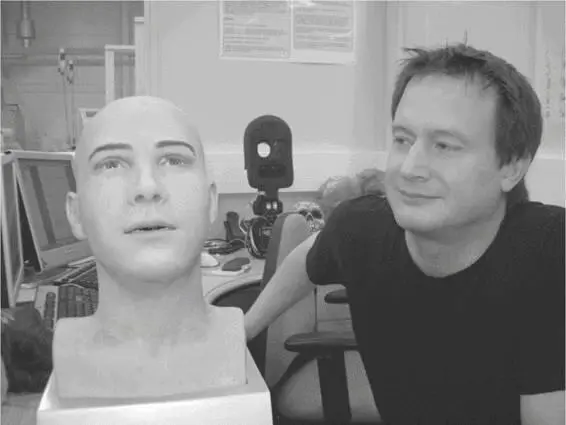Bruce Hood - The Domesticated Brain - A Pelican Introduction (Pelican Books)
Здесь есть возможность читать онлайн «Bruce Hood - The Domesticated Brain - A Pelican Introduction (Pelican Books)» весь текст электронной книги совершенно бесплатно (целиком полную версию без сокращений). В некоторых случаях можно слушать аудио, скачать через торрент в формате fb2 и присутствует краткое содержание. Год выпуска: 2014, ISBN: 2014, Издательство: Penguin Books Ltd, Жанр: Старинная литература, на английском языке. Описание произведения, (предисловие) а так же отзывы посетителей доступны на портале библиотеки ЛибКат.
- Название:The Domesticated Brain: A Pelican Introduction (Pelican Books)
- Автор:
- Издательство:Penguin Books Ltd
- Жанр:
- Год:2014
- ISBN:9780141974873
- Рейтинг книги:4 / 5. Голосов: 1
-
Избранное:Добавить в избранное
- Отзывы:
-
Ваша оценка:
- 80
- 1
- 2
- 3
- 4
- 5
The Domesticated Brain: A Pelican Introduction (Pelican Books): краткое содержание, описание и аннотация
Предлагаем к чтению аннотацию, описание, краткое содержание или предисловие (зависит от того, что написал сам автор книги «The Domesticated Brain: A Pelican Introduction (Pelican Books)»). Если вы не нашли необходимую информацию о книге — напишите в комментариях, мы постараемся отыскать её.
The Domesticated Brain: A Pelican Introduction (Pelican Books) — читать онлайн бесплатно полную книгу (весь текст) целиком
Ниже представлен текст книги, разбитый по страницам. Система сохранения места последней прочитанной страницы, позволяет с удобством читать онлайн бесплатно книгу «The Domesticated Brain: A Pelican Introduction (Pelican Books)», без необходимости каждый раз заново искать на чём Вы остановились. Поставьте закладку, и сможете в любой момент перейти на страницу, на которой закончили чтение.
Интервал:
Закладка:
Back in the 1960s, artificial intelligence was a new field of science that promised us a labour-saving future where robots clean the house, wash the dishes and basically perform all the mundane chores humans hate to do. Since then we have witnessed remarkable developments in computing and technology and there are certainly very smart vacuum cleaners and dishwashers. But we still have not been able to build a robot that perceives the world like a human. They may look human but they are unable to solve some of the simplest problems we take for granted, ones that most babies master before their first birthday.
Another reason why the blank slate cannot be true is because it turns out to be physiologically wrong. Our senses are pre-configured in anticipation of the sorts of signals that we can expect as babies. We do not have to learn to distinguish different colours, or that a boundary between brightness and darkness corresponds to an edge. If you measure from brain cells that react to sensation in unborn animals before they have had any experience of the external world, they will already respond to features that they have not yet encountered.Human newborns will show immediate preferences for some patterns before they have had any time to learn them, so their world is not totally confusing. These early capabilities show that there is considerable formatting in the newborn’s brain that enables them to make sense of experiences.

Figure 2: Spot the difference
Like a computer that you buy from a store, the brain already comes with an operating system installed. What you eventually store on it really comes down to what you do with it. Biology and experience work together to generate a developing mind, adapted to the external world. That process is one of discovery as each child goes about decoding the complexity of the world around them by using the tools that evolution has bestowed upon them.
Getting wired up
The brain of any animal is as complex as it needs to be to solve the world problems that the creature has evolved to accomplish. In other words, the more versatile an animal’s behaviour, the more sophisticated their brain. 4This versatility comes from the capacity to learn – storing memories as patterns of electrical connectivity in the specialized brain cells that alter in response to experiences. In the human adult, the brain is comprised of an estimated 170 billion cells, of which 86 billion are neurons. 5The neuron is the basic building block of the brain’s communication processes that support thoughts and actions.
Each neuron looks like a many-tentacled creature from outer space with a body from which branch thousands of receptors or dendrites that receive incoming signals from other neurons. When the sum of incoming nerve impulses reaches a critical threshold, the receiving neuron then discharges its own impulse down the axon to set off another chain reaction of communication. In this way, each neuron acts like a miniature microprocessor. The patterns of nerve impulses that spread across the vast network of trillions of neural connections are the language of the brain as information is received, processed, transmitted and stored in these networks. The presentations of experiences become re-presented, or representations – neural patterns that reflect experiences and the internal computing processes our brains perform when interpreting information.
One of the more surprising discoveries about brain development is that human infants are born with almost the full complement of neurons that they will have as an adult. Yet the newborn brain weighs about a third of the adult brain. Within a year, it is about three-quarters the size of the adult brain. 6Connections form at a rate of 40,000 per second in the newborn, which is over 3 billion per day. 7Eventually, the length connecting fibres will extend to an estimated 150–180,000 km – enough wiring within an individual human brain to circumnavigate the world’s equator four times. 8In fact, the bulk of the brain is mostly connections, with the neurons squeezed into 3–4mm of the outer layer that covers the surface of the brain, called the cortex after the Latin word for ‘bark’.
These changes in connectivity enable the world to shape the brain by experience because experience keeps the neurons active through repeated mutual activation. This shaping process is called plasticity after the Greek word plassein , meaning ‘to mould’. Synapses between cells that are in constant communication change in their sensitivity so that messages transfer more easily between them. At its most basic level, this is how information is stored in the brain – as changing patterns of neuronal activity. This crucial role for reciprocal neuronal activity is captured in the first of the neuroscientist’s principles of plasticity, ‘cells that fire together, wire together’. 9
Most brain plasticity occurs during child development, with some areas continuing to change well into the late teenage years. The front part of the brain, associated with decision-making, does not become fully mature until the child reaches adulthood. Of course, there is plasticity in the adult brain as we constantly learn throughout our lifetime. However, connectivity in some brain systems seems to be time sensitive, requiring input much earlier in development. Remember neural activity is metabolically expensive. If neural connections are not active, then why keep them? In many ways it is similar to pruning your favourite rose bush. You cut away the weaker branches in order to allow the stronger branches to flourish.
These windows of opportunity, which are sometimes called critical periods, reflect the way that Nature has produced a brain that anticipates specific experiences at certain times; if these are denied or impoverished, there may be long-term impairment. This is true for the sensory systems such as vision and hearing, but as we will read in the next chapter, there appear to be critical periods for social skills as well. This loss of function due to deprivation is a second principle of plasticity, where you have to ‘use it or lose it’ when it comes to keeping neural mechanisms functional.
Core knowledge
In the same way that our brain is pre-configured to experiences before we have even had the chance to encounter the relevant sensations, some scientists believe that we are also wired to interpret the world in particular ways before we have had the chance to think about it. The speed at which babies acquire and understand aspects of the world around them before they are capable of comprehending spoken language indicates that they must be working things out fofigr themselves. As adults, we take it for granted that the world is made up of objects, spaces, dimensions, plants, animals and all manner of complex ideas that we rarely take the time to consider because we have had a lifetime of exposure to them. But how do young babies come to appreciate these concepts in the absence of language? When a baby looks around its new blurry world, what does it make of it all? Even if they are learning by themselves, how do they know what to pay attention to and what is relevant? These sorts of problems have led to the proposal that some key components of understanding the world, especially those related to the physical nature of objects, numbers and space, must be programmed into the brains of infants from birth. But how do we know what babies are thinking when they are not even capable of telling us what is on their minds? The answer comes down to showing them magic tricks.
The reason that we find magic tricks so entertaining is that they violate our expectations. When a magician makes an object vanish into thin air, we are first surprised and then set about trying to figure out how they achieved the illusion. As adults, we know that a physical law has only apparently been violated because if we did not have that understanding, then we would not be surprised. That is why it is a trick. The same is true for babies. When they are shown magic sequences where objects appear to vanish, infants look longer. They do not applaud or gasp as an adult audience would, but they notice that something is not quite right.
Читать дальшеИнтервал:
Закладка:
Похожие книги на «The Domesticated Brain: A Pelican Introduction (Pelican Books)»
Представляем Вашему вниманию похожие книги на «The Domesticated Brain: A Pelican Introduction (Pelican Books)» списком для выбора. Мы отобрали схожую по названию и смыслу литературу в надежде предоставить читателям больше вариантов отыскать новые, интересные, ещё непрочитанные произведения.
Обсуждение, отзывы о книге «The Domesticated Brain: A Pelican Introduction (Pelican Books)» и просто собственные мнения читателей. Оставьте ваши комментарии, напишите, что Вы думаете о произведении, его смысле или главных героях. Укажите что конкретно понравилось, а что нет, и почему Вы так считаете.











